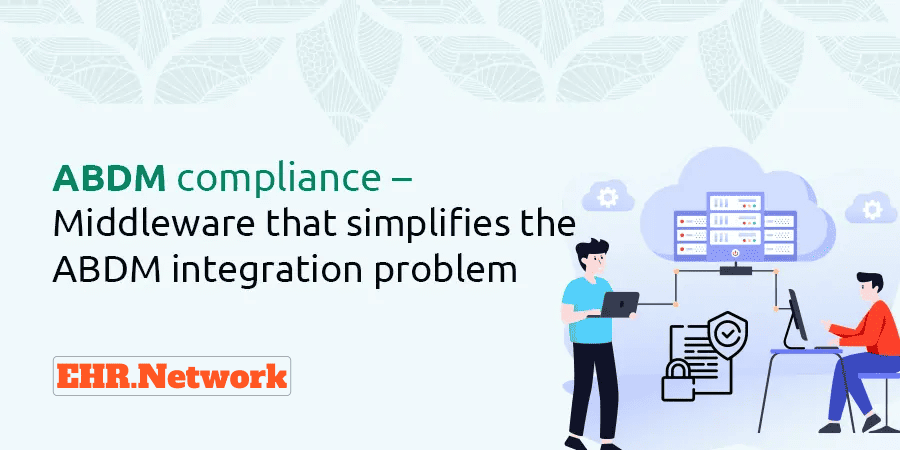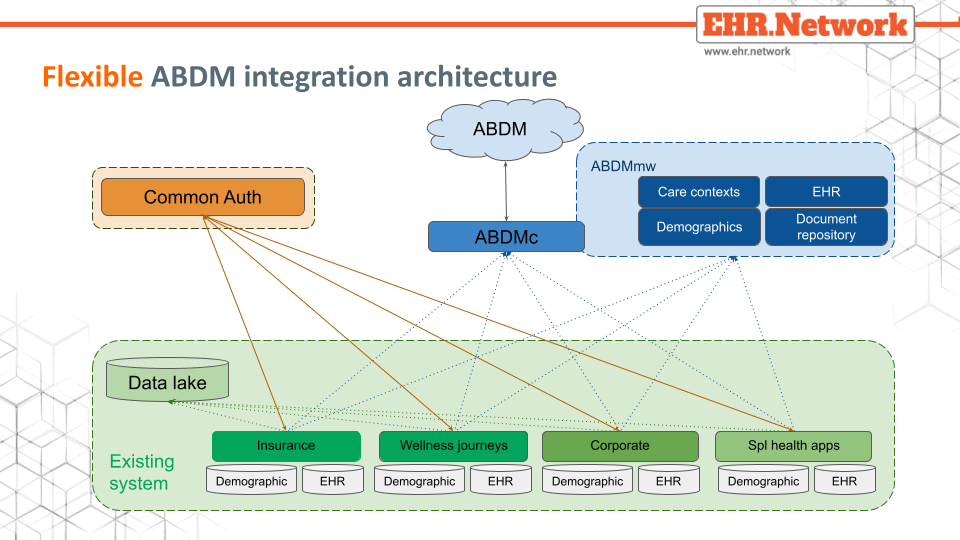✅ ABDM Middleware: Seamless Integration for Healthtech Systems

Enable effortless ABDM compliance without re-engineering your legacy applications
What is ABDM Middleware?
EHR.Network’s ABDM Middleware (ABDMmw) is a ready-to-deploy solution that simplifies ABDM compliance for healthtech platforms. Built as an extension of our powerful EHR middleware, it enables your systems to exchange health data via the ABDM network—without major architectural changes.
⚙️ Works seamlessly with ABDM Connect (ABDMc) to deliver a full-stack ABDM integration solution.
Why Choose ABDM Middleware?
Modern healthtech applications often use custom forms, data schemas, and internal repositories. These don’t natively align with the Indian EHR standards mandated by ABDM.
Upgrading your systems from scratch involves:
- Extensive re-engineering
- Costly redeployment
- Time-consuming user retraining
Our plug-and-play middleware eliminates these hurdles—offering quick integration, low cost, and zero disruption.
Key Features & Benefits
🔄 End-to-End Data Interoperability
Map and convert custom health data into ABDM-compliant formats with minimal changes to your backend systems.
🧑⚕️ Patient & Practitioner Management
- Automatically handle ABHA numbers and ABHA addresses
- Avoid redundant entries in existing patient and practitioner registries
📦 CareContext Management
Create and manage CareContexts to organize and link patient records for easy discovery and access.
⚡ Event-Driven Workflows
Automatically trigger ABDM-specified events such as:
- CareContext linking
- hiType and SMS notifications
🔐 Consent & Compliance Controls
- API-driven consent management
- Handle consent revocation, expiry, and auditing seamlessly
How It Works

✔️ The middleware enriches your data with the required metadata
✔️ No need to modify your internal database structures
✔️ External data is filtered to avoid polluting internal registries
✔️ Outbound and inbound data are securely managed as per ABDM norms
Deployment Options
- ✅ Cloud-hosted
- ✅ On-premise
- ✅ API-first for maximum flexibility
- ✅ Fully compatible with existing workflows and databases
Designed for:
- 🏥 Hospitals & Clinics
- 💊 Pharmacy Networks
- 🔬 Diagnostics Providers
- 🧩 Legacy Healthtech Platforms
Get ABDM-Certified. Faster. Smarter.
Don’t let technical complexity delay your digital health innovation.
Let EHR.Network’s ABDM Middleware handle the heavy lifting.
📅 Book a call with our expert
📝 Request for details
Middleware APIs
https://docs.ehr.network/apidocs/ehrmw.html
Features
- Manage Patient, Practitioner & Organization ABDM profiles
- Manage complete ABHA profile of patients including their ABHA address & ABHA number
- Repository for outgoing clinical data
- Policy based data push from health systems for sharing
- Repository for incoming data.
- Flexible formats to fetch received data by health systems – FHIR, openEHR, custom
- Deletion of received data for regulatory compliance
- openEHR and FHIR repository options
- ABDM CareContext for discovery & linking
- Triggers for careContext linking, hiType notification & SMS notification
Advantages
- Decoupling of ABDM & application workflows
- Independent evolution of applications and ABDM integration layer
- Application initiated integration data
- Reduced dependency allows independent application team plans
- Framework to implement compliance to ABDM policies
- Option to involve users in data scoping shared data
- Centralized component to implement future ABDM changes
- Manage schema mismatch between ABDM shared data & applications
Also read
- ABDM Connect for a simplified ABDM integration
- Ayushman Bharat Digital Mission, The backbone to support an integrated digital health infrastructure for India